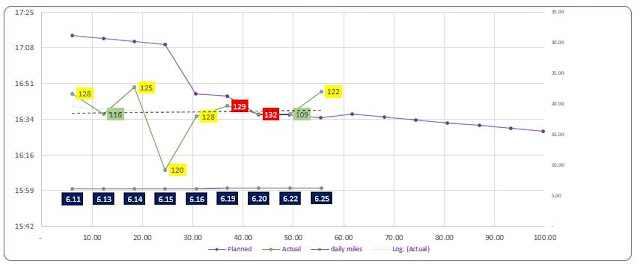Introduction
Maffetone says most of our training should be done in our Aerobic Training Zone which is 180 minus our age to 10 beats below that. I'm 62, so my training range is 108 to 118. I'm currently unable to stay in this range while running, so I use 128 as my maximum allowable average heart rate during a run.
Maffetone says Training = work + recovery
I added stress so Training = work + recovery + stress
Stress is anything other than my training runs which causes physical or mental fatigue resulting in a higher heart rate on my next run.
This morning, I hit upon the concept of Balanced Training. In perfectly balanced training, I'd be completely recovered by the next day's run, and my heart rate would be at or below 128 on the next day. Paradoxically, the way to know if training is in balance is to occasionally exceed my maximum heart rate on training runs. Otherwise, I wouldn't know if I was giving my optimum training effort on any given day.
Work
Procedurally, I try to ignore my heart rate while running, and check the Fitbit website after my run to see how I did. I found trying to keep my heart rate low for every step of runs led to slower times and no progress. Instead, I use a click track (metronome) on an audio book to set the stride rate for the day. Until it stops working, I'm increasing my stride rate by .06 steps per minute each day. This will ultimately improve my times.
In an ideal world, we'd be able to perfectly analyze ourselves each day to see if, how far, and how fast we should run that day. In the real world, we rationalize to get the answer we want. At least I do. If left to my own analysis, I'd run too many miles too fast and end up injuring myself, burning out, or inducing cumulative fatigue. How did I fix this?
I set mileage goals which will increase my distance one or two hundredths of a mile each training day. I maintain the target stride rate for the run and increase it each day. These may change if I hit a wall in my training program.
The heart rate is my heartless coach. If it exceeds 128 bpm, I must take the day off. If it's 128 bpm or less, I run the next day unless there is another reason I shouldn't.
Recovery
It's possible to get lost forever in books and other sources while learning what happens in the recovery phase. I'm not going to do that, but I will give some examples of things that improve on rest days.
- Heart strength
- Muscle Strength
- Muscle cell rejuvenation
- Increase in size of all blood vessels
- Mental rejuvenation
- Bone strengthening
- Repair of minor injuries
- Skin toughening
- Etc., etc., etc.
It's enough to say stuff gets better, and not worry too much about the details. You may observe many of them as they happen.
Today's Run
11/19/15 (Run 12)
Temperature: 27
Wind: Calm
Distance: 6.30 miles
Stride Rate: 127.66
Average pace/mile: 15:59
Charts
It would be easy to say if it wasn't for the relatively short period where my heart rate was high, it would have not exceeded my maximum of 128 bpm. It would have taken only six beats less in over an hour and a half of running. Without a firm maximum, there is no maximum, so I'm not allowing myself to run tomorrow.
Today's run was outstanding. I had negative splits in each mile and beat my personal best in four out of six miles. It was my best time for six miles. The reason for this is the higher stride rate is beginning to force me at times into actual running instead of fast walking with my arms up. I'm making adjustments for running both up and downhill.
Since this is the second day in a row I beat my personal best for six miles, I wanted to run again tomorrow. You can probably see where that would head. Instead, on the next run I'm going to give myself permission to run a bit slower in order to keep my heart rate under better control.
I'm way ahead of the target speed I expected at this point in my training plan. This isn't a bad thing as the training plan was a guess. The target speeds will adjust based on trailing seven day averages.
Conclusion
Taking recovery days after exceeding my maximum target heart rate gives me a rigorous method of balancing work and recovery to achieve the most training in the fewest miles and the fewest days. This should avoid injuries, which can lead to a big loss in training miles and time. It may not be the best method, but I can see it is a method that works.





















